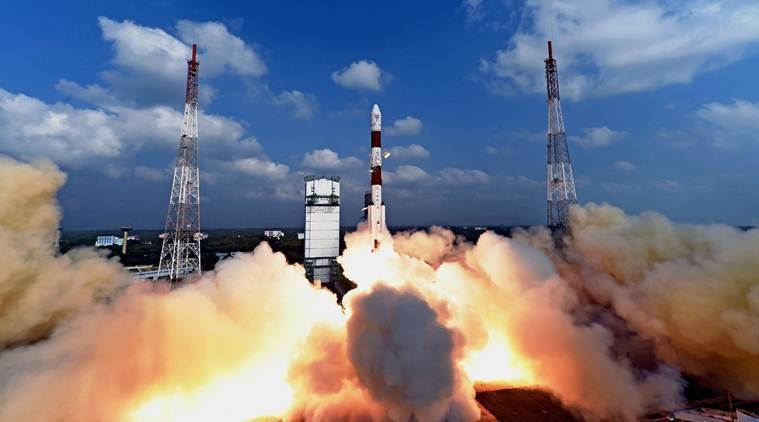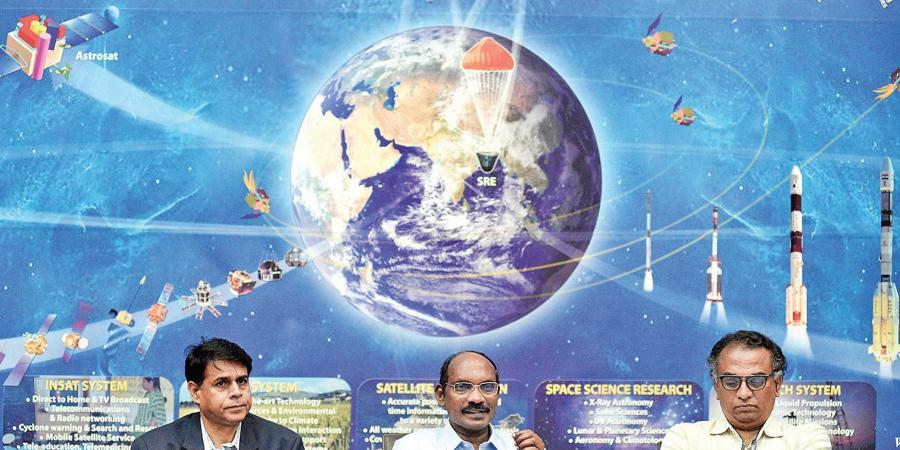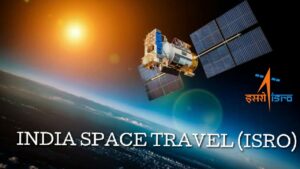On 22th July 2019, India’s second lunar mission Chandrayaan-2 was launched and inserted into the lunar orbit on 20th August 2019, exactly one year ago.
Today, 20th August 2020 Chandrayaan-2 has completed one year in orbit round the moon and every one instruments are currently performing well with adequate on board fuel to stay it operational for about seven more years, confirmed statement by the space agency ISRO.

Chandrayaan-2 mission was India’s first attempt to make a soft-landing of a traveller on the unchartered South Pole of the lunar exterior. it had been propelled for expansion of data about the moon by some detailed analysis of moon’s geography, mineralogy, outer compound structure, thermo-physical physiognomies and atmosphere, resulting in an improved understanding of the derivation and advancement of the moon.
While we celebrate this accomplishment in Space and Research as a nation, investors are watching it because the new field of monetary enhancement.
‘Space sector may well become the new gold rush’: Anand Mahindra.
Indian Businessman and top Industrialist Anand Mahindra has insisted that the Government should build structures and systems that were not existing earlier, along with light-touch policies to enable the Space sector to grow with private sector participation.
He is certain that the Indian Space sector holds the required technology and advancements required to grow in the right direction if it attains the monetary compensation that it deserves.

Speaking at a webinar on ‘Unlocking India’s Potential in Space Sector’ on Thursday, Mahindra said India should now progress to a space-faring nation from a space exploration nation.
He said the global space sector is expected to touch $3.3 trillion by 2045 from $350 billion in 2018. India’s share is miniscule.
Public-private partnership will help India increase the share and take the country towards a space-faring nation.
“We’re at an important juncture of space commercialisation. India is looking at a huge opportunity,” said Mahindra.
Government strategy to bring private players in ISRO and boost India’s space sector.
The recent announcement of the Government of India to support the rise of the private sector in the space industry is signalling that policymakers are keen to see the Indian private companies capture a share of the worldwide space market.
Under the Modi government’s vision of increased public-private partnership, private companies are expected to contribute to putting together launch vehicles and providing launch services, building satellites and providing satellite services, and providing “space-based services.”, commented by
At a conference – ‘Unlocking India’s Potential in Space Sector’, scientific secretary of Indian Space Research Organisation (ISRO), R. Umamaheswaran proposed the new structure of partnership, informing the roles of all the firms and organisations involved. He also stressed on the the need to update policies.

The guiding principles for involving the private sector will be based on the Space Activity Bill, satellite communications policy, remote sensing policy and navigation policy, among others.
The Department of Space will help private players through the process and also aid in the creation IN-SPACe, which will be responsible for permitting and monitoring private sector space activities, licensing players, regulating said activities and facilitating use of ISRO facilities.
To streamline and make user-friendly the process of private player application to IN-SPACe (Indian National Space Promotion and Authorization Centre), ISRO stated that it has launched an online portal where applicants can submit their requests. These will then be checked out by the technical, legal, and therefore the safety & security directorates, which can evaluate the applications and also list the type of support and facilities needed.
The next space race- Private space industrialization is here.

In recent years, the entire space industry has been waiting and checking out what’s getting to function the gold rush of space. One could talk endlessly about the importance of space for humanity and therefore the way technologies developed by and for space activity help to unravel problems on Earth: satellite imagery, weather, television, communications.
Currently, the whole space economy doesn’t exceed $100 billion, which can be a smaller amount than 0.1% of the worldwide economy. It is very low in comparision to the late 1990s where the whole capitalization of companies in this sector amounted to quite 5% of worldwide GDP.
Why will Privatisation will be a boon to ISRO according to NASA.
India has possibly taken its first big step therein direction with the central government fixing New Space India Limited (NSIL) earlier and now IN-SPACe (Indian National Space Promotion and Authorization Centre).
Both flow from the announcements made by Union Finance Minister Nirmala Sitharaman in the fourth tranche of Rs 21 lakh crore special Covid-19 economic package.

ISRO already has tie ups with around 150 private companies. To put in perspective, the Nasa engages with quite 375 space companies. There has been a requirement for greater involvement of personal players in India’s space sector to form ISRO more competitive with leading global players.
At present, the ISRO undertakes two to three major satellite launches a year. The Pillai committee recommended a greater role for private sector for using ISRO facilities for satellite launch taking the number of annual launch to 15. More engagement of private sector means more money for ISRO to do its basic work of space research and exploration.
IN-SPACe will ensure A level playing field for personal companies to use Indian space infrastructure and a friendly regulatory environment. This opens up the possibility that private players can soon be building and launching satellites in a gradual manner.
The meagre predictions and prowling risks of Space Privatisation:
Before discussing these in detail, it should first be clarified that ISRO is not being privatised, not yet at least. Second, nevertheless, there are lurking dangers inherent in the extent and direction to which space is opened up to the private sector.
The basic idea of involving outside agencies, either public or private, within the Indian space sector, is really almost as old as India’s space programme itself. The idea was to gradually build capabilities in Indian industry to broaden the industrial base and set up a supply chain for advanced technologies, while enabling ISRO to focus on R&D, new technologies, space exploration, and development and defence-related applications.
The real potential dangers lie in how future directions in space are envisaged and driven by Government, rather than ISRO, which has little option but to follow. If economic process and interests of personal players come to dominate, one can foresee a big drop by application-oriented space programmes, with the govt declining to fund ISRO and requiring it to raise funds from private customers, with the latter being disinterested in many of these programmes.

Only some commercial space activities such as communication and geo-location may survive, while other application-oriented programmes may shrink, leaving mainly costly space exploration and manned space flights to ISRO, with the government constantly bemoaning high costs, with little or no tangible returns as in the US. Self-reliance too may suffer with commercial players preferring launch services from other countries or getting into foreign collaboration for satellites, instruments and therefore the like.
The other danger is in strategic areas. Most space applications have dual civilian and military applications. Civilian launchers and missiles share technologies and, in many countries, use the same rocket engines. ISRO has taken great pains to develop self-reliant capabilities in space technologies, and sharing such technologies with the private sector, except under strict controls, can cause undesirable consequences.
After Coal, Gold and Crypto-currency, is Space Mining the next big thing?
Fast paced developments are happening within the field of space mining technology with private players within the lead. Optical mining using concentrated sunlight, robotics, automated mining applications, advanced drilling machines etc are just a couple of examples.
Participation of personal players has reduced the investment burden and greatly enhanced the width and pace of innovation. it’s believed that launch of the primary asteroid mining vehicle also as fixing of the primary fuelling stations on the Moon and in low earth orbit could become a reality within a decade.

Private players like SpaceX, Blue Origin and Virgin Galatic have also become major space industry players.
The global space economy today is worth about $ 360 billion and is estimated to grow to trillions by 2040. US, Russia, China, Japan, Australia, Euro Space Agency (ESA) and even alittle country like Luxemburg which has 10 registered space mining companies, are already within the race.
In contrast to the present , India accounts for a meager 3% of the worldwide space industry today. The amazing pace of latest developments in space technology and its huge budgetary requirements are making even developed countries to collaborate with others. These factors combined with the apparent legal tussle and intense struggle for a slice of the ‘space pie’ that lies ahead, is for certain to go away space explorers’ like ISRO who operate alone, far behind.
Therefore, collaboration with other leading space players, without further delay, is clearly the sole way forward for India. India’s existing space prowess and its ability to contribute its due and justifiable share of monetary support will make it a welcome partner in any space alliance.
ISRO Chief K Sivan: ‘Space sector reforms not aimed at ISRO privatisation’

Participating in a webinar ‘Unlocking of India’s Potential in Space Sector’, ISRO Chairman K Sivan said the main aim of the reforms was to enable the private sector companies to engage in space research and activities. But this is not to be understood as steps to privatise ISRO, he said.
“When the space sector reforms were announced by the government, there were misconceptions about it leading to privatisation of ISRO. It is not. I repeat: It is not privatisation of ISRO,” Sivan said.
Sivan said with the opening of the space sector, the country’s space agency could focus on technology development and capacity building and facilitate private sector participation in major national missions through announcement of opportunity.
India’s Space Activities Bill is aimed at providing a dedicated space legislation for India with a much-increased role to play for the private players in the space sector. The draft bill was made public for comments by ISRO in November 2017.
This would mean a win-win to both ISRO and the private sector. While ISRO can focus on long term technology and scientific developments, routine requirements can be met by the private sector. This will enable the private sector to use the developed space structures and capabilities to sell both the satellites and the imagery-based services in the global markets to add to their customer base.
The question though remains — whose job will it be to coordinate all of this and if leaderships in both ISRO and the legacy private sector are ready for such changes. Such risks are being taken by some of the emerging space start-ups but without much support from ISRO. If they succeed, they will stand as inspiration for much of those legacy models to vary .



